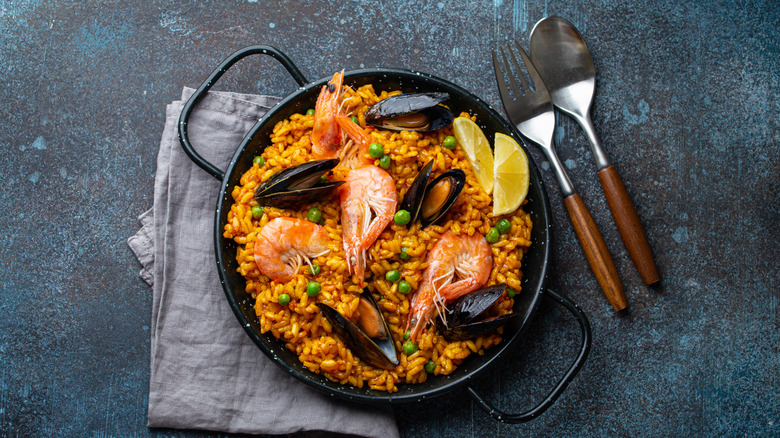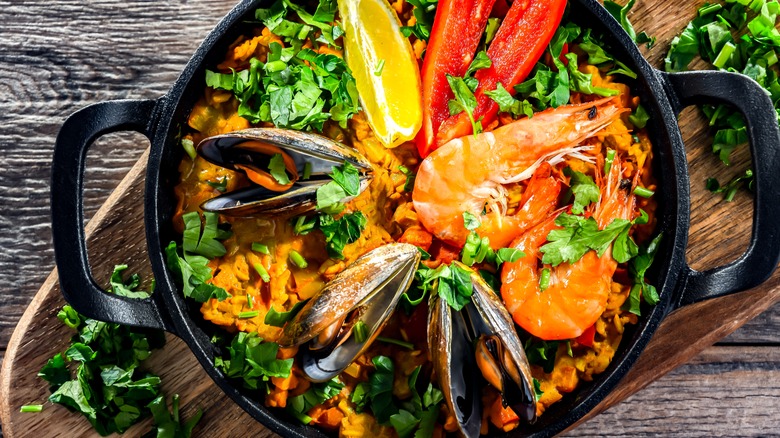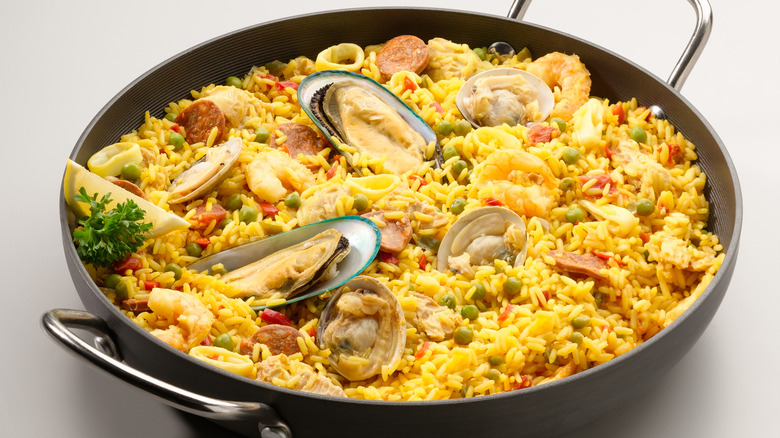Cut Paella Prep Time Way Down With Canned Clams And Mussels
No food represents Spain better than paella, a traditional saffron rice dish cooked with a colorful array of seafood, meat, and vegetables. Renowned for its rich flavors and vibrant presentation, this classic Spanish recipe takes root in the coastal city of Valencia, where working class residents first began to make it as a humble meal that utilized any over-abundance of ingredients they had on hand.
Today, paella has become popularized across the globe and, at the same time, become infamous for its lengthy cooking time, which takes about an hour at least from prep to finish. Thankfully, there are ways to expedite the lengthy cooking process, and it involves swapping fresh clams and mussels for canned versions.
Because mussels and clams are filter feeders that live at the sandy bottom of the ocean, they both require a lot of washing in order to remove any residue grit and get them ready for cooking. Even mussels that are farmed in ropes, which never reach the ocean floor and therefore don't contain much sand, can sometimes grow beards that require removal as well. The beard is not dangerous to consume, but it taste is rather offputting and will ruin the flavors of an otherwise excellent paella.
Canned clams and mussels are not exact replicas to their fresh counterparts, but they will save you precious time in the kitchen by already coming prepared and ready to eat. Just remember to add the tinned shellfish to your paella about 5-10 minutes before serving to avoid overcooking them.
Save time by popping the pan into the oven
Beyond subbing in canned clams and mussels to save some time in paella making, there's another trick — and it involves using your oven rather than stovetop. Traditionally, paellas are made in a paellera, a far-ranging but shallow skillet that allows for the saffron rice to develop a rich, crunchy crust at the bottom called the socarrat.
While paella even gets its name from this Spanish cookware, you can actually use a regular cast iron skillet to make a smaller batch of it. In fact, using cast iron allows you to finish your food in the oven, expediting the cooking process even further. Pans made out of cast iron are notoriously durable. Provided that you keep them clean and dry, they can distribute scorching hot heat with little to no problem.
As you begin to sauté your vegetables and aromatics for the dish, preheat your oven to around 500 degrees Fahrenheit. Once you're done searing your aromatics, add in your rice and stock, then pop it in the oven. The hot convection air will considerably speed up how long your paella takes to absorb the liquid, allowing you to make and enjoy it in a pinch.
Other cooking tips when making paella
Paellas are all about caramelization. Whether you're following a conventional recipe or getting experimental by making a chic quinoa paella with shellfish, you'll want to sear any fresh proteins or vegetables before dropping in your rice and stock. The browning will partially dissolve into your stock and infuse into your grains as they cook, creating a dish with a more complex taste. If you're using fresh shrimp, you can fortify the flavors even further by leaving their shells on as they cook. Should you choose to add chicken as well, choose bone-in dark meat cuts such as drumsticks or thighs that will withstand the lengthy simmering process.
Well-made paellas will always have a socarrat exterior that crackles as you cut and bite into it. However, you won't get this browned exterior if you're overly jostling your rice, so don't disturb the ingredients in your pan too much as you add in your canned seafood and garnishes near the end of the cooking process. You also don't want to add in vegetables that release a lot of water, such as onions, as they will turn your paella into mush and ruin its texture.



